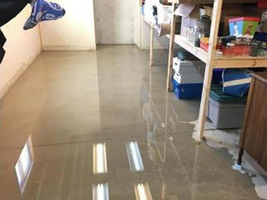
Most people drive their sump pumps with their main power line. But, have you ever thought of the times of power outage.
Power outage is expectedly normal in the days of heavy storms or cyclones. And possibilities are high that those are the days your sump pump has its job to do. If your sump pump doesn’t work that very moment, your basement is likely to be flooded and you will get a lot of trouble afterwards. So, have you any backup plan in cases of electricity outage?
How to Backup My Sump Pump for Electricity Outage
Here are three backup systems we suggest for empowering your sump pumps in times of power outage.
People, having their personal preferences and needs can choose between these followings—
Click a link below to jump to the relevant section
1. Buy a Generator Backup
The most sustainable backup option for empowering your sump pump when the electricity is gone is by installing generators for your sump pumps. Generators are the safest and trustworthy solution for the sump pump drainage problems.
You can simply connect your sump pump with your home generator. This would solve half of your problem at once. But there is a problem with connecting your sump pump with the home generator.
It is that your sump pump keeps pumping constantly whereas it is not needed. Sump pump needs to be run in intervals. So, it would be wise to connect with a portable generator so you can control the runtime and empower other gadgets when needed.
People usually buy a dedicated small size generator for their sump pump. However, dedicated generators for sump pumps are often neglected and are usually not prepared for the worst weather.
So, it’s best to have a medium-size generator that can occupy both a sump pump and two or more other gadgets. That way it will keep in use and you will automatically remember to fuel it up for any day.
2. Get a Battery Backup
If you haven’t bought a generator for backing up your sump pump for the worst days, then this backup system is for you. Batteries and pumping systems are easily available in your nearest hardware store. It’s a cheaper and easy-to-install option as well.
For installing a battery backup for your sump pump, you put in an additional pump in the sump pit. It’s put alongside the electric powered pump and hooked into the same discharge line as the primary electric pump.
So, when the power goes out and the electric-powered pump doesn’t work, this battery-empowered pump takes over. And it pumps the excessive water out of the sump and saves your basement.
However batteries do not last very long. So, even if you have got the best battery backup for your sump pump, keep on checking every once in a while whether it’s functional or not. And try to replace it within every 3 to 5 years.
3. Keep a Water Backup
Water backup system is a smart way to empower your sump pump using the city water. Because in this backup system it uses city water to empower a pump. So, when electricity is gone, it takes over and restarts the sump pump.
The problem with this system is that you only can empower your pump with a municipal water system, like the city water supply. Because a municipal water system creates water pressure even if without electricity. It will drive the pump. Well water cannot create that kind of pressure and empower the pump.
However, the installation will require a professional up at the ceiling level and make a good discharge line to drain out the water. It’s a tricky system but, the amazing thing about this backup system is you don’t need any power supply or battery for it. It’s all ready to go anytime it’s needed.
No Backup for Sump Pump Failure, What to Do?
Some of you still haven’t arranged for a backup solution to function your sump pump, just because it rarely ever rains in your area. However, if it suddenly floods though, you better move fast.
So here are some actions that can be taken in case you have no other backup system for your sump pump failure. Even if you have backups, you should be ready for these in the worst cases.
1. Wet or Dry Vacuuming
If you don’t have a sump pump and floodwater starts to stand in the basement, a dry or wet vacuum is the best DIY for you. Just a 5-10gallon wet or dry vacuum cleaner will do the task.
Simply vacuum the excess water and discharge it into a bucket. And drain the bucket outside of your house. This takes a lot of your labor, and occasionally it’s okay. But if you need to do it frequently, better switch with a backup option.
2. Drain Out by Manual Hand Pumping
Suppose, you do not have a sump pump, neither do you have a generator to power up the vacuum machine. What are you gonna do then? Sit back and let your basement get flooded away, or get ready with a hand pump.
Put the hand pump into the sump pump hole to pump out the water. Moreover, you can attach a garden hose pipe to drain the water out of your house.
3. Drain With Trash Water Pumping
In serious flooding a hand pump or vacuum cannot come in any use. In that case, you will need a portable powerhouse trash-water pump machine.
These trash-water pumps are gas-fueled and can pump out large amounts of water along with soft solid like dirt. These pumps are efficient. But if you do have a sump pump, we still recommend to switch for a permanent backup system.
Final Words
Sump pumps are a must for each and every house in modern days. Regardless of the general weather, the most losses come with the unexpected natural disasters.
Any moisture trapped in your basement can produce mold and cause severe damage to your properties. So, always have a backup plan for your sump pump failures and keep your basement dry.
